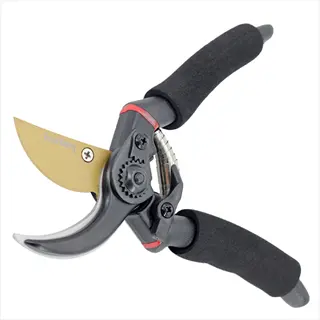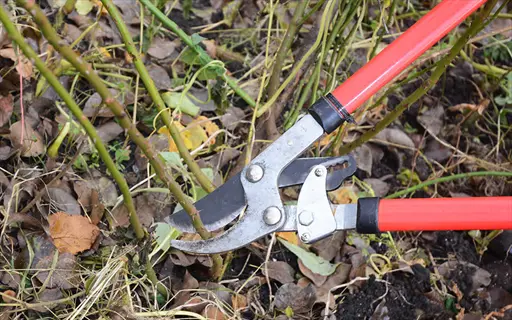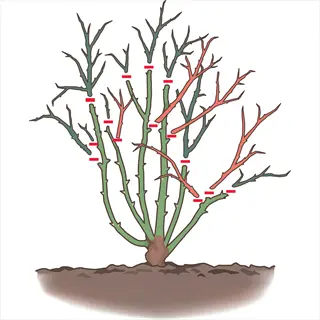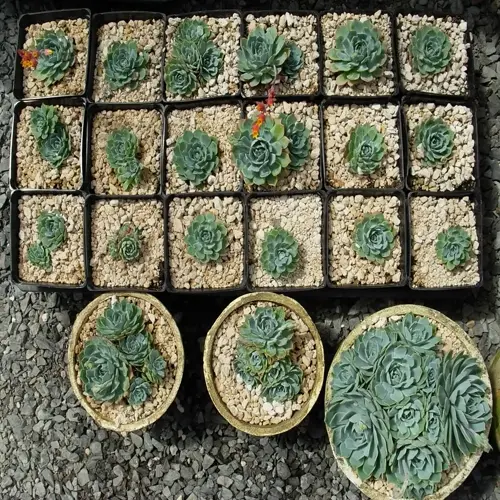How to Prune Roses for Vibrant Blooms

Written by
Michael Sullivan
Reviewed by
Prof. Martin Thorne, Ph.D.Discover how to effectively prune roses with bypass pruners to make accurate, 45-degree cuts.
Prune in late winter dormancy, when the buds are starting to swell, for maximum blooming potential.
Begin by removing dead wood, and then remove crossing branches to create an open center for the plant.
Pruning heights will vary depending on rose type. For example, hybrid teas will need lower cuts than the climbing roses.
It is important to disinfect your tools after each plant, and also put on a dormant spray to avoid spreading any diseases.
You may also want to deadhead the blooms that have faded, so that you will encourage new flowers over the summer and into fall with as much brightness as possible.
Article Navigation
Mastering rose pruning changes your landscape and improves plant health and flower quantity. Well-done pruning stops diseases from spreading and enhances new growth. Regular upkeep enables roses to become more resilient. You can depend on beautiful blossoms throughout the growing season.
If you're new to rose care, take it easy and start with small steps. Start with dead wood. Observes how the roses respond until you attempt larger cuts. Roses are tough plants and will recover from deliberate pruning. Each successful season builds confidence.
Proper pruning aids the garden broadly. Increases airflow to stems. It prevents fungal diseases. Your labor produces beautiful flowers. Remember, the sharper the tool, the cleaner the cut. Healthy roses begin with the right technique.
Essential Pruning Tools
Properly using bypass pruners is important for a clean cut. You want to use tools that can handle stems no thicker than 0.75 inches in diameter. Thicker canes should be cut with loppers. I keep both of these in my gardening apron at all times. If the blades are dull, they will crush the stem rather than cleanly slice through it. This ruins and damages the plant tissue.
Ensure that you sanitize your tools after every plant. For example, I would dip my blades in alcohol or some bleach solution. This way, you will not transfer any diseases to or from your roses. I've also made it a habit to keep disinfectant wipes around when pruning. A clean tool preserves your whole garden. It literally only takes seconds, but it makes a big difference.
Use arm protection against thorns. Long leather gloves save your arms. I learned this the hard way after getting gouged deeply. Getting punctured up to the full height of your forearm is NOT a fun experience. Arm protection prevents any nasty, painful injuries. Protective clothing allows you to work without discomfort. Thorn-resistant types still throw thorns at you, so no matter what, be careful!
Keep blades sharp each month. Ensure pruners are sharp before every major pruning session. Sharp tools create clean cuts. To test sharpness, start by testing on paper first. If it tears and doesn't cut, then resharpen. Proper maintenance can keep your tools going for years.

Bypass Pruners
- Precision Cutting: Makes clean angled cuts on stems up to 0.75 inches (1.9 cm) thick without crushing delicate rose tissues for optimal plant healing
- Selection Guide: Choose models with comfortable grips and overlapping blades that operate smoothly during extended pruning sessions in the garden
- Maintenance Protocol: Sharpen blades monthly using a whetstone and lubricate pivot points regularly to maintain peak cutting performance
- Thickness Limitation: Never exceed 0.75 inches (1.9 cm) cutting capacity to avoid damaging both the tool and the plant structure
- Angle Technique: Position blades perpendicular to canes at 45-degree angles facing away from buds to direct growth outward properly
- Disease Prevention: Sanitize after each use with 70% isopropyl alcohol to eliminate pathogens that could infect healthy plants

Loppers
- Leverage Advantage: Long handles provide mechanical advantage for cutting thick canes up to 1.5 inches (3.8 cm) in diameter with minimal effort
- Blade Design: Bypass models create cleaner cuts than anvil types which can crush living tissue and invite disease into plants
- Proper Positioning: Ensure jaws fully surround the cane before cutting to execute a single clean slicing motion through the wood
- Size Selection: Test different handle lengths to find models that match your height and provide comfortable reach into bushes
- Thickness Capacity: Designed specifically for stems between 0.75-1.5 inches (1.9-3.8 cm) where pruners become ineffective
- Storage Care: Wipe blades after use and hang vertically to prevent spring fatigue and maintain cutting alignment

Pruning Saws
- Heavy-Duty Cutting: Curved blades cut through mature woody canes exceeding 1.5 inches (3.8 cm) thick with controlled precision
- Safety Feature: Foldable designs protect blades during storage and prevent accidental injuries when reaching into dense bushes
- Cutting Technique: Use short pull strokes instead of pushing motions to maintain control and avoid tearing plant tissue
- Teeth Configuration: Triple-ground teeth stay sharper longer and cut efficiently in both directions through dense wood grain
- Handle Comfort: Wooden handles with ergonomic contours reduce hand strain during prolonged cutting sessions in the garden
- Maintenance Tip: Clean sap residue after each use and occasionally apply blade oil to prevent rust formation

Tool Sanitizer
- Disease Prevention: Eliminates cross-contamination risks when moving between plants during extensive pruning operations
- Effective Formula: 70% isopropyl alcohol solution kills pathogens instantly without leaving harmful chemical residues
- Application Method: Dip or spray blades thoroughly after finishing each bush and allow complete air drying before storage
- Frequency Requirement: Sanitize before starting work and after encountering diseased wood to protect healthy roses
- Storage Safety: Keep in clearly labeled spray bottles away from heat sources and out of children's reach
- Alternative Solutions: Household bleach diluted 1:9 with water works when alcohol isn't available for disinfection

Long Gloves
- Armor Protection: Gauntlet-style designs extending to the elbow shield skin from thorns and prevent scratches during pruning
- Material Durability: Synthetic leather or thick canvas resists punctures while maintaining tactile sensitivity for precise work
- Secure Fit: Adjustable wrist closures prevent soil and debris from entering while allowing flexible hand movements
- Comfort Feature: Breathable mesh panels reduce sweating during warm weather gardening sessions with extended duration
- Sizing Guide: Measure hand circumference and arm length to select gloves that don't restrict blood circulation
- Care Instructions: Hand wash with mild soap and air dry to preserve protective qualities and extend product lifespan
Best Time to Prune
The best time to prune roses in most areas is during winter dormancy. Keep an eye out for bare canes and swelling buds as Mother Nature's time clock. In USDA zones 3-4, the best time is in April after frost has passed. Warmer zones, 9-10, start in January. Don't prune if temperatures are below freezing (<32°F/0°C) or above 90°F (32°C).
Structural pruning is performed annually while the plants are dormant. Deadheading is done each week during the summer. Major cuts are made when buds are swelling but not yet open, allowing the wound to heal before spring growth begins. Never prune a plant when it is flowering or during extreme heat.
Check your local weather forecast before pruning to ensure optimal conditions for the task. If the weather forecast indicates that the temperature is predicted to drop below 32°F (0°C) within 2 days, I skip pruning. High heat exposure, above 90°F (32 °C), can typically cause sunscald on previously exposed canes. Once I have made fresh cuts, I want to protect those fresh cuts from weather stress.
Observe your roses for the initial bud development. Look for swollen reddish buds. That's the perfect moment to begin. Bare canes point toward full dormancy. I keep a calendar marked when I see buds forming. Visually, it is better than using dates. Your roses will tell you when they're ready.
Late Winter (Primary Window)
- Optimal Period: February to March in most regions when plants are dormant but buds begin swelling
- Temperature Range: 40-60°F (4-15°C) allows cuts to heal before spring growth surge
- Regional Adjustments: January pruning in zones 9-10; April-May in zones 3-4 after last frost
Early Spring (Catch-up Period)
- Secondary Window: Late March to early April if winter pruning missed
- Precautions: Complete before leaves fully unfurl to avoid stressing new growth
- Limitations: Delayed pruning shifts bloom cycle later in summer months
Summer (Deadheading Only)
- Ongoing Maintenance: Remove spent blooms weekly June-August to encourage reblooming
- Temperature Caution: Avoid pruning above 90°F (32°C) to prevent sun scald on exposed canes
- Technique: Cut back to first five-leaflet junction below flower cluster
Fall (Minimal Cuts)
- Light Shaping: Early October pruning to reduce wind damage on hybrid teas
- Restrictions: Never cut more than 1/3 of plant height to avoid stimulating new growth
- Dormancy Prep: Leave rose hips on plants in zones 7+ to trigger dormancy naturally
Absolute Avoidance Periods
- Frost Risk: No pruning when temperatures drop below 32°F (0°C) within next 48 hours
- Heat Stress: Pause during heat waves above 95°F (35°C) to prevent cane dehydration
- New Growth Phase: Delay during rapid spring shoot emergence to avoid energy diversion
Step-by-Step Pruning Guide
Begin by removing dead or diseased wood. Bypass pruners are used to cut 0.25 inches (6 mm) above a healthy bud. Look for canes that break open to brown pith inside. Be sure to disinfect your tools after each diseased plant. I use 70% alcohol wipes between rose plants to ensure that I do not spread any infection.
Choose primary canes larger than a pencil diameter (0.25 inches/6 mm). Cut any thin growth at ground level. Select 3-6 strong canes spaced evenly around the plant. This selection focuses energy on stronger blooms. I use writing implements to help visualize thickness.
Recognize outward-facing buds before completing cuts. Outward-facing means they are not pointing toward the center of the plant. Cut just above that bud at a 45° angle, using a depth of 0.25 inches (6 mm). This effectively opens up the structure of the rose, allowing for better airflow. I often help gardeners visualize this by running their finger along the direction of the bud.
Sanitize tools after every rose. I carry multiple pruners for large pruning jobs, allowing me to rotate them. Clean blades stop the transmission of black spot and/or powdery mildew. Make this automatic, like putting on gloves. Your roses will show their appreciation with strong growth for the entire season.
Remove Dead/Diseased Wood
- Identification: Cut into canes until reaching healthy white pith; brown indicates dead tissue
- Technique: Cut at 45° angle flush to base or nearest healthy bud junction
- Sanitization: Disinfect blades after each diseased cane using 70% alcohol
Eliminate Crossing Branches
- Goal: Create vase-like shape by removing inward-growing canes
- Selection: Prioritize removal of canes rubbing against others
- Cut Position: 0.25 inches (6 mm) above bud collar without damaging it
Trim Weak Growth
- Diameter Threshold: Remove stems thinner than pencil (0.25 inches/6 mm)
- Cut Height: Base-level removal to redirect energy
- Exception: Keep pencil-thin canes if they fill structural gaps
Select Primary Canes
- Quantity: Choose 3-6 robust canes spaced evenly around plant
- Health Check: Green bark with plump buds and no lesions
- Cut Height: Remove others 1 inch (2.5 cm) above ground
Make Final Cuts
- Position: 0.25 inches (6 mm) above outward-facing bud
- Angle: 45° slope away from bud for water runoff
- Direction: Ensure bud faces exterior to open plant center
Seal and Clean
- Large Wounds: Apply white glue to cuts >0.5 inches (1.3 cm)
- Debris Removal: Clear all clippings within 3 feet (90 cm) radius
- Final Sanitization: Wipe tools before storing
Pruning Different Rose Types
Hybrid teas require pruning annually, to 12-18 inches (30-45 cm) to induce large exhibition blooms. Prune above buds on the outside of stems at 45° angles. Floribundas require a bit more space, ideally 24-36 inches (60-90 cm), for clusters of blooms.
Climbing Roses have special considerations regarding lateral branches. Cut the laterals back to 3-5 buds at a precise 45° angle. Retain the main structural canes. I horizontally mount mine along fences to produce numerous blooms. Deadhead spent blooms, but retain the main framework.
Lower tall roses slowly across two or three seasons. Don't remove more than one-third of each height each year. Cut down to 6 feet (1.8 m) in the first year, then 4 feet (1.2 m) the next year. This helps prevent shock and allows for reshaping larger plants.
The process of deadheading varies widely between types. While hybrid teas can be cut back to the first five-leaf junction, shrub roses need nothing besides the removal of the spent bloom. Climbers need only minimal deadheading as well. I adapt my method to the growth pattern of each rose.
After-Pruning Care
Use dormant spray immediately after pruning, ideally within 24 hours. The dormant spray will cover all your cuts to protect against the introduction of pests, such as aphid eggs. I generally try to minimize health issues on dry days, especially when the temperature is over 40°F (4°C). Use a sufficient amount in your spray to the point of runoff so that every cane is covered. It will also suppress possible fungal infections.
Water thoroughly, covering the root zone with 1 inch (2.5 cm) of water. I recommend using drip irrigation for slow and easy water absorption into the soil. The aim here is to properly hydrate the stressed plants without wetting the tops. I use a finger test about 1" down to check for any moisture before lightly watering again. Adequate hydration allows plants to heal quickly.
Fertilize only when the growing temperature is above 50°F (10°C), and wait 2 or 3 weeks after pruning. Use a 10-10-10 Nitrogen-phosphorus-potassium (N-P-K) balanced formula, at a rate of 1/2 cup (120 g) per plant. Distribute the fertilizer 12 inches (30 cm) away from the base of each plant. Water immediately to activate the fertilizer nutrients.
Spread 2-3 inches (5-7.5 cm) of mulch around the roses and at least 4 inches (10 cm) away from the base of the canes. I like to use compost or shredded bark. This layer conserves moisture and stabilizes soil temperature. Continue to add mulch as it breaks down.
Apply Dormant Spray
- Purpose: Coats canes to suffocate overwintering pests like aphid eggs and fungal spores
- Timing: Within 24 hours of pruning before new growth emerges
- Coverage: Spray until runoff occurs on all canes and bud junctions
Deep Watering
- Amount: 1 inch (2.5 cm) depth across root zone to hydrate stressed plants
- Technique: Use drip irrigation or soaker hose for slow soil penetration
- Avoid: Overhead watering that wets foliage and spreads disease
Fertilize Appropriately
- Timing: 2-3 weeks after pruning when temperatures exceed 50°F (10°C)
- Formula: Balanced 10-10-10 NPK at 1/2 cup per plant (120 grams)
- Application: Spread evenly 12 inches (30 cm) from base and water in
Mulch Application
- Material: 2-3 inch (5-7.5 cm) layer of compost or shredded bark
- Purpose: Conserves moisture and regulates soil temperature
- Placement: Keep 4 inches (10 cm) clear from cane bases to prevent rot
Monitor and Protect
- Sun Protection: Shield newly exposed canes with burlap if temperatures exceed 85°F (29°C)
- Pest Check: Inspect weekly for borers; seal entry points with white glue
- Growth Tracking: Document bud swell progression to refine future pruning
5 Common Myths
When pruned below visible buds, roses will die because they don't have the ability to develop new growth points.
This statement is incorrect because roses have dormant auxiliary buds on their canes that will become active after pruning. Even below a visible bud, these dormant buds will produce new growth. The important aspect is to prune with a clean 45-degree angle cut 1/4 inch (6 mm) above the orientation of any bud for the plant to direct its energy to the remaining buds efficiently.
Roses of every kind require hard pruning every year to keep healthy and promote new bloom.
Different rose kinds have different pruning needs. Hybrid tea roses will want an annual cut back to about 12 to 18 inches (30 to 45 cm) from ground. So-called shrub roses need only light shaping every 2 to 3 years. Climbing roses may need a limited cut of main canes but regular lateral trims. Remember that over-pruning of roses causes stress and minimizes blooms.
It is important to apply pruning sealants to protect cuts from diseases and insect infestations.
However, based on modern gardening practice, sealants simply trap moisture and cause decay. In the case of cuts of less than 1/2 inch (1.3 cm), it is best to allow the wound to heal naturally. The only exception would be applying white glue to a wound larger than 1/2 inch (1.3 cm) in an area prone to pests. Making proper 45-degree angled cuts to shed water, along with the sanitizing of tools, is best in order to avoid other more serious issues than applying the sealant.
Pruning in fall helps roses get ready for winter by encouraging root growth and hardening the canes.
Pruning in fall can actually create new growth that will not have time to harden before frost. So fall pruning should only be done with the intention of reducing height by a maximum of 1/3 to prevent wind damage. The most important prep for winter is to leave the rose hips for winter dormancy signals. Reserve structural pruning for late winter dormancy.
Removing spent flowers at any time during the season robs the rose of potential energy that could subsequently be used.
Deadheading takes energy away from seed production (rose hips) and channels it into new flowers. Cut back spent flowers to the first five-leaflet junction and, at the same time, to a 45-degree angle above an outside-facing bud and you will prolong blooms from summer into fall anyway. Always sterilize your shears between plants to prevent potential disease spread.
Conclusion
Pruning roses greatly enhances the flowering and lifespan of the plants. Proper technique will give you bigger, brighter blooms year after year. Proper pruning will extend the life of your rose bushes. And with time, this care becomes increasingly enjoyable.
Timing is crucial for achieving maximum results. Late winter pruning continues the natural growing processes. These cuts float, and the healing process begins before spring. This will give you the best chance of bloom production. Given that many plants indicate when they are ready for pruning, it is optimal.
Correctly pruning will significantly reduce disease spread. When you make clean cuts and sanitize your tools, the risk of infection is reduced. Air can circulate easily with open centers. Good technique with your roses should keep them healthier. This protection also benefits your whole garden.
Begin pruning your roses with confidence this season, starting simply with the removal of dead wood. Build your skills gradually. The roses will reward your labor with beautiful flower displays. The very first cut will lead to a lifetime of beautiful gardens.
External Sources
Frequently Asked Questions
When is the optimal time to prune roses for best results?
Prune roses during late winter dormancy when buds begin swelling, typically February-March in most regions. This timing allows cuts to heal before spring growth. Avoid fall pruning which can stimulate frost-vulnerable new growth. Always complete pruning before leaves fully unfurl.
What are the essential steps for proper rose pruning?
Follow this sequence:
- Remove dead/diseased wood down to healthy white pith
- Eliminate inward-growing canes to open the center
- Trim stems thinner than a pencil (0.25 inches/6mm)
- Select 3-6 robust primary canes spaced evenly
- Make final cuts 0.25 inches above outward-facing buds at 45° angles
What happens if roses aren't pruned annually?
Unpruned roses develop overcrowded centers that restrict airflow, increasing disease susceptibility. Energy diverts to woody growth instead of blooms, resulting in smaller, fewer flowers. Canes become tangled and prone to breakage. Pest infestations escalate in dense foliage.
How should I deadhead roses for continuous blooming?
Cut spent blooms back to the first five-leaflet junction below the flower cluster. Make angled cuts 0.25 inches above an outward-facing bud. Perform this weekly during summer using sanitized pruners to encourage reblooming and maintain plant shape.
What critical mistakes should I avoid when pruning?
Never:
- Prune during freezing temps or above 90°F (32°C)
- Leave stubs longer than 0.25 inches above buds
- Cut to inward-facing buds causing congested growth
- Remove over one-third of plant height in one season
- Use dull tools that crush rather than cleanly slice canes
How does pruning height vary between rose types?
Adjust based on variety: Hybrid teas need reduction to 12-18 inches, floribundas to 24-36 inches, while shrub roses require minimal height trimming. Climbers need lateral trimming but main cane preservation. Always keep at least 3-6 healthy primary canes.
Why is the five-leaf rule important for roses?
This guideline ensures proper deadheading cuts. Five-leaf junctions contain strong buds that produce robust flowering stems. Cutting here directs energy to quality blooms rather than weak three-leaf junctions. Always cut just above these points at 45° angles.
What aftercare is crucial following pruning?
Essential steps include:
- Apply dormant spray within 24 hours to prevent pests
- Water deeply with 1 inch (2.5cm) across root zones
- Apply balanced fertilizer after 2-3 weeks
- Mulch with 2-3 inches of compost, kept from cane bases
- Monitor for borers and shield canes from intense sun
Should I use pruning sealants on cuts?
Modern research shows sealants often trap moisture and promote decay. For cuts under 0.5 inches, natural healing is best. Only consider white glue for larger wounds in pest-prone areas. Focus instead on proper angled cuts that shed water.
How frequently must tools be sanitized during pruning?
Sanitize after every diseased plant and between all plants when moving between roses. Use 70% isopropyl alcohol or 1:9 bleach solution. This prevents spreading black spot, powdery mildew, and other diseases through contaminated blades.

